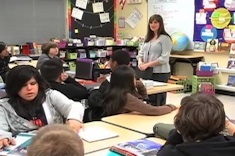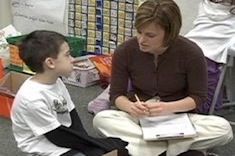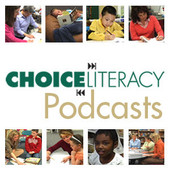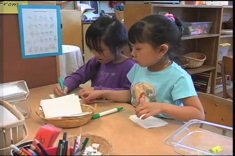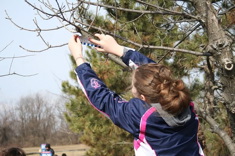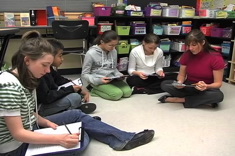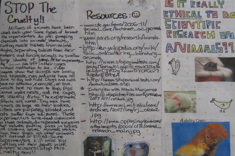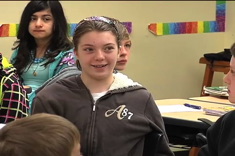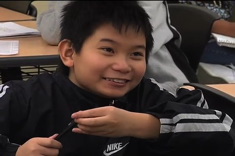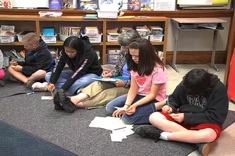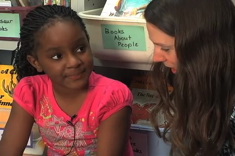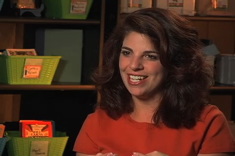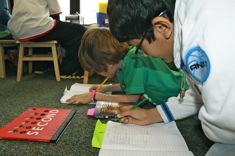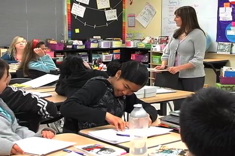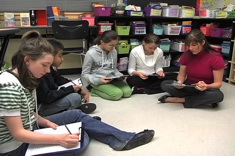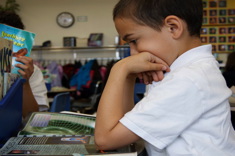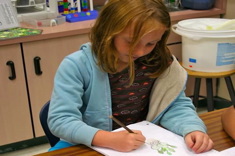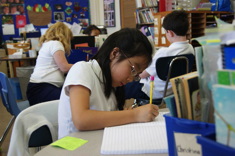Teaching Writing
Everyone who writes for Choice Literacy loves teaching writing, because we all write ourselves. We know it is "hard fun," as Donald Murray famously said—exasperating and exhilarating at the same time. The writing workshops you will read about here and see in our videos are busy, noisy, vibrant places. And most days, we wouldn't want to be anywhere else than in the midst of 'em! Here is where you'll find our latest discoveries, insights, and occasional boneheaded mistakes in teaching writing.
Latest Content
“I Am the One Who . . .” Building Writing Skills and Community in Middle Schools
In this 12-minute video, Katie Doherty leads her sixth-grade students as they try the prompt “I am the one who . . .” during writing workshop. This is an excellent activity for building classroom community.
Preschool Morning Message
This five-minute video from Melissa Kolb's preschool classroom shows the value of morning message for teaching literacy skills. Melissa explains the skills children develop during this brief whole-class lesson and sharing time.
Teaching Blogging to Second Graders
You’re never too young to blog, as Katie DiCesare demonstrates with her 2nd graders.
Conferring in First Grade
This nine-minute video from Katie DiCesare’s first-grade classroom demonstrates a range of conferring in the midst of writing workshop.
Using Comics in Literacy Workshops
Franki Sibberson works with her 3rd and 4th graders to use comics in the literacy workshop.
Ann Marie Corgill on Launching Writer’s Workshop (PODCAST)
Ann Marie Corgill has advice for launching writer's workshop in this podcast.
Literacy Letters: Helping New Students Understand Ongoing Assignments
How do teachers bring new students up to speed with ongoing assignments? In this video from Katie Doherty’s middle school classroom, Katie presents the latest “Literary Letters” assignment to her 6th graders. It is early spring, and all but two of the students have experience with this writing assignment.
A District Film Festival: Giving Kids An Authentic Audience for Their Work
Lights, cameras, and even a red carpet! Bill Bass documents how a film festival brought high school teachers and students together, with a strong focus on connecting district goals and standards to the fun projects.
Preschool Writing Center
In this video from Melissa Kolb’s preschool classroom, children work in the writing center. Melissa explains how she routinely changes the supplies in the center to spark interest in students and make connections to their experiences.
Injecting Writing into Everything: Bringing the Outside In
Heather Rader helps a 3rd grade teacher break through the resistance of some student writers. The magic tool? A dirty onion from the garden.
“The Wrath of Guess Jeans”: Reading, Writing, and Cliques in Middle School
In this first video in a three-part series, Katie Doherty leads her 6th graders through a response activity. The text they are reading was written by a middle school student over a decade ago, and its themes of popularity and belonging still ring true for students.
Persuasive Pamphlets
Erin Ocon and her middle-school students observe some political activists passing out pamphlets outside the building for a few moments. Voila – the pamphlet project is born. Pamphlets are the perfect genre for teaching persuasion and summary, two key skills highlighted in the Common Core.
“The Wrath of Guess Jeans”: Response and Read Around
In this second video in a three-part series, Katie Doherty leads her 6th graders through a response activity. In this installment, the students respond orally and share some of their writing, making links to pop culture and other books from reading workshop.
Pamphlets on Books (Part 2 of the Persuasive Pamphlets Series)
Erin Ocon finds pamphlets are a terrific format for teaching her middle-school students persuasive writing and summary skills. In this essay she explains how to use pamphlets for book recommendations. This is the second installment in a two-part series.
“The Wrath of Guess Jeans”: Debrief
In this third video in a three-part series, Katie Doherty leads her 6th graders through a response activity. The text they are reading was written by a middle school student over a decade ago, and its themes of popularity and belonging still ring true for students. In this installment, Katie debriefs with students about the value of the writing activity.
Helping Children Build Notetaking Skills
Whose job is it to teach notetaking skills? Heather Rader finds teachers often expect colleagues in previous or subsequent grades to teach these skills, as well as a lot of hesitancy about how best to instruct students. She presents a simple notetaking template and describes how she uses it to help students learn how to list important details with words and images.
Writing and Publishing Book Reviews with Middle School Students
What teenager doesn't enjoy critiquing everything in the world? Erin Ocon puts that judgmental passion to good use in her classroom with a book review assignment.
Family History Inquiry Project: Integrating Technology with Social Studies in First Grade
Julie Johnson explains how a family history inquiry project in her first-grade classroom built technology, literacy, and research skills as students explored many cultures.
Injecting Writing into . . . Everything: Ellipsis Stories
"DOT DOT DOT" – a phrase made famous in Mama Mia, it's also the spark for some writing instruction linked to read alouds from Heather Rader.
The Nuts and Bolts of the Family Inquiry Project
Julie Johnson explains how a family history inquiry project in her first-grade classroom builds technology, literacy, and research skills as students explored many cultures. This article is the second in a two-part series.
Injecting Writing into Everything: Prediction Stories
What happens between kindergarten and upper elementary grades to make students more hesitant about making predictions? Heather Rader has books and teaching suggestions for building prediction skills.
Quick Take: Time Constraints in Conferences
In this two-minute video, Aimee Buckner explains how she deals with time constraints when she is conferring with students.
Drawing to Learn: Conferring with Kyle
In this conference with six-year-old Kyle, Ruth Shagoury listens to him explain the stories and meaning behind his drawings during writer's workshop. Kyle's first language is Vietnamese, though English is also spoken in the home.
Procedural Writing in Math
Heather Rader explains how mentor texts for math instruction need some specific attributes.
Seedfolks: Connecting Community and Literature
There's so much to do during the first weeks of school, but it's important not to skip the most important thing – building a sense of community with your students.
First Grade Guided Writing Group: Targeting Common Spelling Needs
In this video of a 1st grade guided writing group, Katie DiCesare works with children to address common issues with spelling and conventions. By grouping the students together, she is able to use her time well in addressing common needs among students.
Linking Reading, Writing, and Getting to Know You Activities During the First Week of Middle School
Want to get your middle school students’ attention on the first day of school? Read a book about how to ruin it for them.
Rethinking the Study of Nonfiction in the 21st Century
Franki Sibberson reflects on her nonfiction writing unit, and realizes she emphasizes research skills at the expense of the craft of nonfiction writing. She explains how she revamps the unit to help students focus more on writer's craft in nonfiction texts, including some new mentor texts and different ways of using writer's notebooks.
Infographics and Lists in Science Notebooks
Science notebooks are a wonderful tool for building outdoor observation and writing skills. Andrea Smith explains how writing in the notebooks leads students to explore different nonfiction text features like infographics and lists.
Writing Do-Overs: ERPs in the Classroom
ERP. The sound can't help but make you grin. It's Heather Rader's acronym for Explicit Revision for Peers, a series of one-minute kinesthetic writing routines to help students learn how to help each other kindly during writer's workshop.
Browse Content By
Type
Category
- Assessment Tools
- Big Fresh Archives
- Booklists
- Choice Numeracy
- Classroom Design
- Common Core
- Community Building
- Conferring
- Content Literacy
- Digital Literacy
- English Language Learners
- Equity
- Family Relations
- Free Samples
- Guiding Groups
- Leadership
- Literacy Coaches
- Mentor Texts
- Minilessons
- New Teacher Mentors
- Podcasts
- Poetry
- Quote Collections
- Reading Strategies
- Self Care
- Struggling and Striving Learners
- Talking and Listening
- Teacher Study Groups
- Teaching Reading
- Teaching Writing
- Word Study and Vocabulary
Author
- Melissa Quimby
- Nawal Qarooni
- Gwen Blumberg
- Julie Cox
- The Lead Learners
- Hannah Tills
- Josie Stewart
- Ruth Metcalfe
- Mallory Messenger
- Becca Burk
- Jodie Bailey
- Vivian Chen
- Mary Brower
- Tiffany Abbott Fuller
- Stephanie Affinito
- Ruth Ayres
- Leigh Anne Eck
- Heather Fisher
- Shari Frost
- Julie Johnson
- Suzy Kaback
- Gigi McAllister
- Shirl McPhillips
- Melanie Meehan
- Cathy Mere
- Debbie Miller
- Tara Barnett and Kate Mills
- Tammy Mulligan
- Dana Murphy
- Bitsy Parks
- David Pittman
- Brenda Power
- Heather Rader
- Matt Renwick
- Mandy Robek
- Christy Rush-Levine
- Gretchen Schroeder
- Jen Schwanke
- Brian Sepe
- Katherine Sokolowski
- Stella Villalba
- Jennifer Vincent
Grade Level
Choice Literacy Membership
Articles
Get full access to all Choice Literacy article content
Videos
Get full access to all Choice Literacy video content
Courses
Access Choice Literacy course curriculum and training

